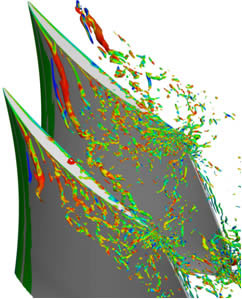Engines
A Further Step in the Modeling of the Flow in Turbine Compressors
Multi-scale modeling of the flow, taking into account the presence of a vane-casing clearance in turbine compressors, paves the way for better performance predictions.
28 November 2012
 Vortices originating at the end of the vanes, in the space between these and the casing, are detrimental to performance.Compressor wheel rotation is possible in aircraft engines because there is a clearance between the vanes and the casing. However, this functional clearance is the source of vortices that hinder engine performance. Optimization, especially to reduce consumption, requires the description of the interaction of these vortices with the high pressure gas flow that feeds the combustion chamber.
Vortices originating at the end of the vanes, in the space between these and the casing, are detrimental to performance.Compressor wheel rotation is possible in aircraft engines because there is a clearance between the vanes and the casing. However, this functional clearance is the source of vortices that hinder engine performance. Optimization, especially to reduce consumption, requires the description of the interaction of these vortices with the high pressure gas flow that feeds the combustion chamber. The difficulty in the numerical simulation of this phenomenon is largely due to differences between the characteristic dimensions of the interacting parts: a few tenths of a millimeter for the gap, to a few tens of centimeters for the main flow.
In the ONERA approach, the Navier-Stokes equations describing fluid flow were solved by an original method developed at ONERA, the ZDES. This method allows all relevant scales of magnitude in the phenomenon to be described with remarkable accuracy and within promising computation times.
This is a technological breakthrough of paramount importance. It will allow engine manufacturers to increase their predictive capabilities for operational configurations